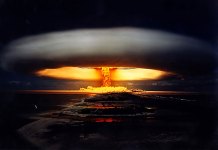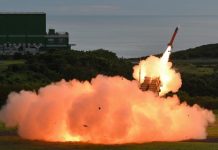The Indo-Pacific region is witnessing what China never hoped to see – joint military drills between Japan, India, Australia and the US. For years, China has been fearful of the Quadrilateral Security Dialogue or QUAD, to be formally activated.
According to experts at EurAsian Times, Beijing’s worst fears have come true. On Tuesday, the US Navy confirmed that it had begun a trilateral exercise in the Pacific with Japan’s Maritime Self-Defense Force and the Australian Defense Force. The Indian Navy also confirmed that the US had joined its naval drill in the Indian Ocean.
America’s aircraft carrier USS Ronald Reagan, guided-missile cruiser USS Antietam and guided-missile destroyer USS Mustin were joined by Australia’s Stuart and Arunta frigates, Hobart destroyer, Canberra landing helicopter dock ship, and Sirius fleet replenishment vessel, as well as Japan’s Teruzuki destroyer.
In the Indian Ocean, the Nimitz carrier, guided-missile cruiser USS Princeton, and guided-missile destroyers USS Sterett and USS Ralph Johnson joined India’s Rana, Sahyadri, Shivalik and Kamorta for joint exercises.
As reported by EurAsian Times earlier, QUAD was an informal security dialogue established to counter growing Chinese influence in the Indian and Pacific Ocean. Although never formalised, the group could not work since China issued all four partners a demarche after it was announced.
Formalization of the QUAD?
Patrick Gerard Buchan, director of the U.S. Alliances Project at the Washington-based Center for Strategic and International Studies says that while India’s level of caution toward the QUAD had been lowered because of the recent border clashes with China, “it hasn’t dropped altogether.” and “No one wants to push the delicate situation,” he said.
Contrary to Buchan’s comments, Stimson’s Lalwani points to the joint exercise between India and the U.S. in the Indian Ocean as a precursor of things to come. “That there were significant U.S. and Indian guided-missile ships deployed together cannot go unnoticed and suggests the potential for formidable air defence and anti-submarine-warfare operations,” Lalwani said.
Another expert, Patrick Cronin, the Asia-Pacific security chair at the Hudson Institute think tank, agrees with Lalwani. “The international naval exercises underway in the Indo-Pacific are just the latest demonstration of India, Australia, and Japan shedding prior inhibitions about multilateral military manoeuvres,” he says.
Expanding the QUAD
Retired Indian Navy Rear Adm. Sudarshan Shrikhande, former head of naval intelligence, has a completely different view and believes that the QUAD could potentially expand to include more neighbours.
“It is possible that we are seeing more signs, not only in the quartet but in more Indo-Pacific capitals that appeasement of China seems to have run its course,” he said. “As a core formulation, the QUAD with perhaps some among ASEAN members may eventually become a useful counterweight to China’s muscle-flexing and ambitions.”
According to Shrikhande, for the QUAD to expand its cooperation needs to be multidomain.
“Increased naval deployments in the Indian Ocean region as well as in the Western Pacific are one aspect, but the diplomatic, economic and even information campaigns to rally closer have not happened anytime in the past.”
The formalization of the QUAD is guaranteed to infuriate China but no one is certain how Beijing will respond. While a conventional war remains out of question, China could resort to non-conventional warfare tactics such as cyber-attacks, proxy wars, insurgency etc.




